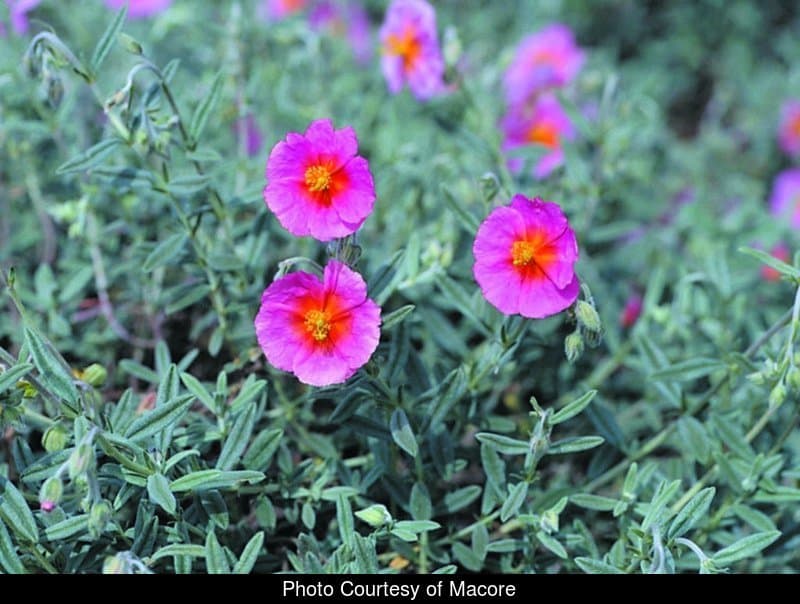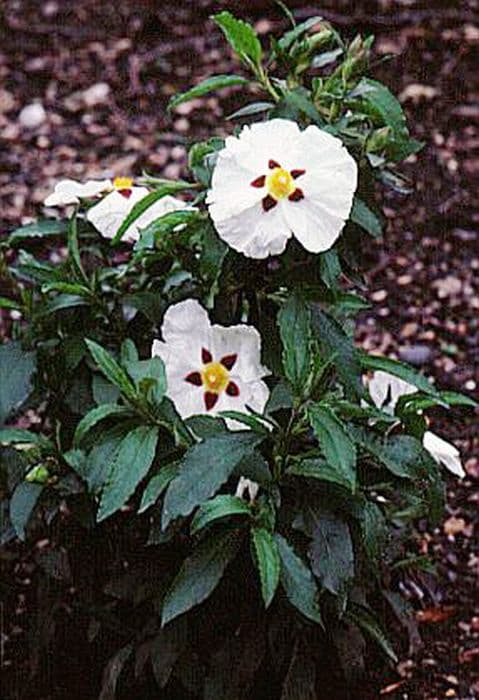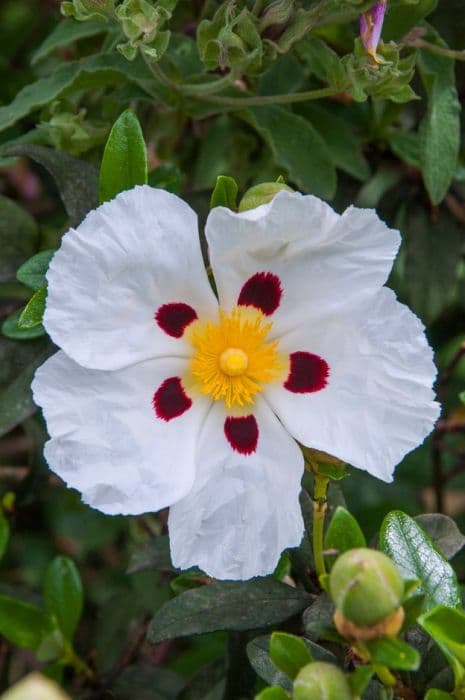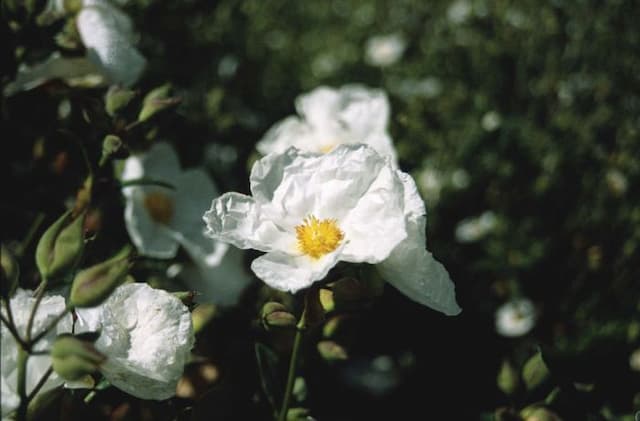Rock Rose Helianthemum 'Ben Hope'

ABOUT
The Helianthemum 'Ben Hope', commonly known as the 'Rock Rose', is a graceful and attractive perennial. It is known for its sprawling habit and dense, semi-evergreen foliage. The leaves are small, ovate-shaped, and typically a bright green to gray-green color, lending a soft, fine-textured appearance to the plant throughout the year. The Rock Rose blooms profusely. Its flowers are distinctive and eye-catching, usually single and saucer-shaped, offering a multitude of colors depending on the variety. The flowers of 'Ben Hope' present a vibrant shade that can range from a sunny yellow to a deeper, golden hue. Each blossom has a central cluster of conspicuous stamens, often a contrasting color which adds to their ornamental appeal. These flowers are held above the foliage on slender stems, creating a delicate, fluttering effect that enhances gardens and landscapes. After blooming, the flowers often give way to small, inconspicuous fruit that carries little ornamental value. Overall, the Rock Rose 'Ben Hope' has a cheerful and robust presence in any setting where it's grown, attracting various pollinators with its colorful, sunny aspect.
About this plant
 Names
NamesFamily
Cistaceae
Synonyms
Ben Hope Rock Rose, Ben Hope Sun Rose
Common names
Helianthemum 'Ben Hope'
 Toxicity
ToxicityTo humans
Rockrose 'Ben Hope' does not have a well-documented history of toxicity to humans. There is no widely recognized evidence that suggests the plant is harmful if touched or ingested. However, it is generally advised not to eat plants unless they are known to be safe and are intended for human consumption. If any adverse reactions are observed after contact with any plant, it is recommended to seek medical advice.
To pets
Rockrose 'Ben Hope' is not commonly known to be toxic to pets. There is limited information regarding its toxicity for animals, but it is not listed as a toxic plant to pets by major animal health organizations. However, as with any non-food plant, it's best to prevent pets from ingesting it, as it may cause gastrointestinal upset or other issues in some animals. If you suspect your pet has ingested part of this plant and is showing adverse symptoms, contact your veterinarian.
 Characteristics
CharacteristicsLife cycle
Perennials
Foliage type
Evergreen
Color of leaves
Green
Flower color
Yellow
Height
1 foot [30 cm]
Spread
1 foot [30 cm]
Plant type
Shrub
Hardiness zones
5
Native area
Europe
Benefits
 General Benefits
General Benefits- Attracts Pollinators: Helianthemum 'Ben Hope', commonly known as rock rose, attracts bees and butterflies, enhancing pollination in the garden.
- Drought Tolerant: The rock rose is well-suited for dry conditions, requiring minimal watering once established.
- Low Maintenance: It is an easy-to-care-for plant that doesn't demand frequent pruning or special care techniques.
- Ground Cover: The rock rose spreads well and can cover ground efficiently, reducing weed growth and soil erosion.
- Decorative Flowers: The plant produces attractive flowers that can add color and visual interest to garden spaces.
- Sun Lover: It thrives in full sun, making it a suitable choice for sunny gardens where other plants might struggle.
- Rock Gardens: Its ability to grow in rocky, less fertile soil makes it ideal for rock gardens and alpine settings.
 Medical Properties
Medical PropertiesThis plant is not used for medical purposes.
 Air-purifying Qualities
Air-purifying QualitiesThis plant is not specifically known for air purifying qualities.
 Other Uses
Other Uses- Photography: The vibrant flowers of the Helianthemum 'Ben Hope' can be used as an attractive subject or backdrop in floral photography, providing a lively splash of color.
- Educational Tool: Schools and educational programs can utilize the plant in botany lessons to teach about plant growth, pollination, and the lifecycle of perennial shrubs.
- Artistic Inspiration: Artists may use the dynamic colors and forms of the Helianthemum 'Ben Hope' as inspiration for paintings, drawings, and textile designs.
- Erosion Control: The dense growth habit of 'Ben Hope' can help stabilize soil on slopes and prevent erosion in landscape settings.
- Living Mulch: The plant can serve as a living mulch, covering the ground densely and helping to retain soil moisture and suppress weeds.
- Habitat Creation: When planted in groups, Helianthemum 'Ben Hope' can provide microhabitats for insects and small wildlife seeking shelter and nesting grounds.
- Dye Production: The pigments in the flowers might be used in natural dye processes for coloring fabrics or yarns.
- Garden Theme Design: It can play a role in themed garden designs, such as rock gardens or Mediterranean-style landscapes, due to its sun-loving nature and appearance.
- Soil Health Indicator: Its health and vigor can act as an indicator of soil conditions, alerting gardeners to the need for adjustments in soil composition or pH.
- Craft Projects: Dried Helianthemum 'Ben Hope' flowers can be used in craft projects such as making bookmarks, potpourri, or pressed flower art.
Interesting Facts
 Feng Shui
Feng ShuiThe Rock Rose is not used in Feng Shui practice.
 Zodiac Sign Compitability
Zodiac Sign CompitabilityThe Rock Rose is not used in astrology practice.
 Plant Symbolism
Plant Symbolism- Sunshine and Positivity: Helianthemum 'Ben Hope', commonly known as Rock Rose, typically represents warmth and positivity due to its bright, sun-like flowers that open up in full sunlight.
- Survival and Resilience: Rock Roses are known for their hardy nature and ability to survive in poor soil conditions and drought, symbolizing the endurance to overcome challenges.
- Transience: The individual blossoms of Rock Rose often last only for a day, which can symbolize the fleeting nature of life and the importance of living in the moment.
- Beauty and Attraction: With its attractive petals, Rock Rose can represent beauty and the power to attract both people and beneficial insects to one's surroundings.
- Healing: Historically, some species of Rock Rose have been used in herbal remedies, which allows them to symbolize healing and restoration.
 Water
WaterThe Rock Rose 'Ben Hope' should be watered deeply to ensure that the water reaches the root zone, typically about once a week, depending on the weather conditions and soil type. During the summer, if the weather is particularly hot and dry, you may need to water more frequently, ensuring that the soil dries out somewhat between watering sessions. Generally, aim for about one gallon per plant for each watering session. It's crucial to avoid overwatering, as Rock Rose does not tolerate soggy soil well. Watering in the early morning is best to reduce evaporation and prevent disease.
 Light
LightRock Rose 'Ben Hope' thrives in a spot that receives full sun for the majority of the day. The plant prefers a location that enjoys at least six hours of direct sunlight daily. Although it can tolerate some partial shade, the amount of bloom may be reduced in less than ideal light conditions. Therefore, a south-facing position or an area without significant shade cover is optimal to ensure healthy growth and flowering.
 Temperature
TemperatureRock Rose 'Ben Hope' performs best in temperature conditions that stay between 50°F and 80°F. Although it can tolerate colder temperatures down to approximately 20°F, it should be protected from frost. Depending on the zone, it may die back in the winter and return in the spring. The ideal temperature range for this plant would be a warm Mediterranean-like climate with moderate temperatures.
 Pruning
PruningRock Rose 'Ben Hope' requires pruning to maintain shape, encourage bushier growth, and promote more blooms. It is best to prune the plant lightly immediately after its blooming period in early summer. Remove any dead or damaged stems and shape the plant as desired. Pruning should be done annually, or as required if the plant becomes overgrown.
 Cleaning
CleaningAs needed
 Soil
SoilRock roses, such as Helianthemum 'Ben Hope', thrive in well-draining soil with a sandy or gravelly composition to mimic their native Mediterranean habitat. They prefer a slightly acidic to neutral pH range of 6.0 to 7.5. A mix consisting of two parts sand or fine gravel, one part topsoil, and one part compost or peat moss creates an ideal growing medium for these plants.
 Repotting
RepottingRock roses like Helianthemum 'Ben Hope' typically require repotting every two to three years. They should be repotted when they outgrow their current container or when the soil starts to deteriorate, whichever comes first. Choose a well-draining pot slightly larger than the current one to prevent water-logging.
 Humidity & Misting
Humidity & MistingRock roses such as Helianthemum 'Ben Hope' are adapted to dry, Mediterranean-like environments and do not require high humidity. They are tolerant of low to moderate humidity levels and are best suited to the dry air commonly found in home and garden environments.
 Suitable locations
Suitable locationsIndoor
Place in bright light, limit water, avoid high humidity.
Outdoor
Full sun, well-drained soil, dry to average moisture.
Hardiness zone
5-9 USDA
 Life cycle
Life cycleThe Helianthemum 'Ben Hope', commonly known as the Rock Rose 'Ben Hope', begins its life cycle with seed germination, typically in the spring when temperatures are warm enough to trigger growth. Seedlings develop into young plants with a rosette of leaves at ground level before they send up flowering stems. During late spring to summer, the Rock Rose 'Ben Hope' blooms with bright yellow flowers that attract pollinators, a critical phase for sexual reproduction and genetic diversity. After pollination, the flowers produce small, dry fruits containing seeds that will disperse to start a new generation. The plant is a perennial, surviving year after year by going dormant in the winter, retracting back to the woody base and resuming growth when favorable conditions return. Throughout its life, it will continue this cycle of seasonal growth, flowering, seed production, and dormancy.
 Propogation
PropogationPropogation time
Spring-Summer
The Rock Rose 'Ben Hope' is most commonly propagated through semi-ripe cuttings taken in summer. For this method, you'll need to select healthy, semi-ripe shoots that have not fully hardened off yet. Normally, these are cut to a length of about 2 to 4 inches (5 to 10 centimeters). The leaves on the lower half of the cutting are removed, and the cut end can be dipped in rooting hormone to encourage root growth. The prepared cuttings are then inserted into a pot filled with a mixture of perlite and peat moss to provide a well-draining growing medium. It is important to maintain a humid environment for the cuttings, which can be achieved by covering the pot with a plastic bag or placing it in a greenhouse, and to keep the soil consistently moist but not waterlogged. Roots typically develop after a few weeks, after which the new plants can be transferred to individual pots and eventually planted out into the garden.









